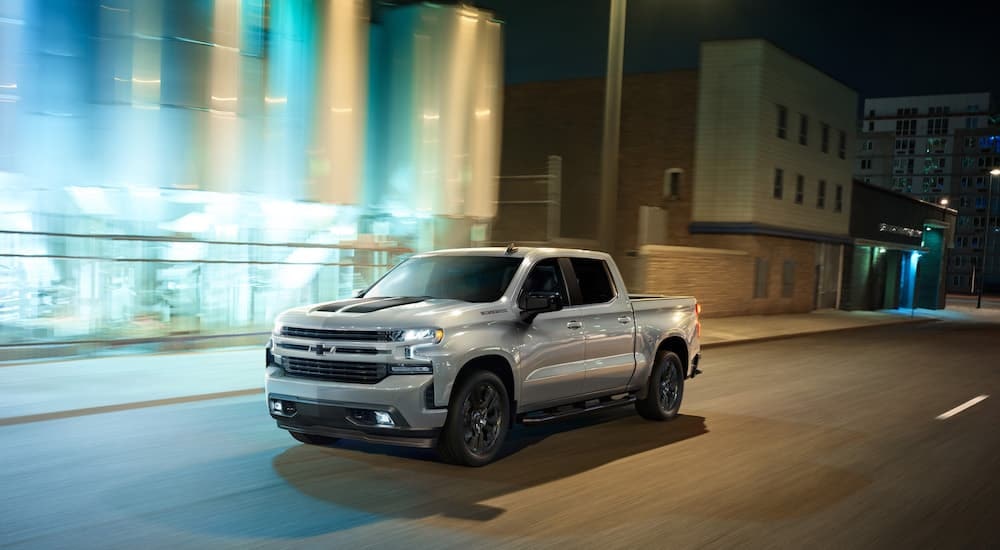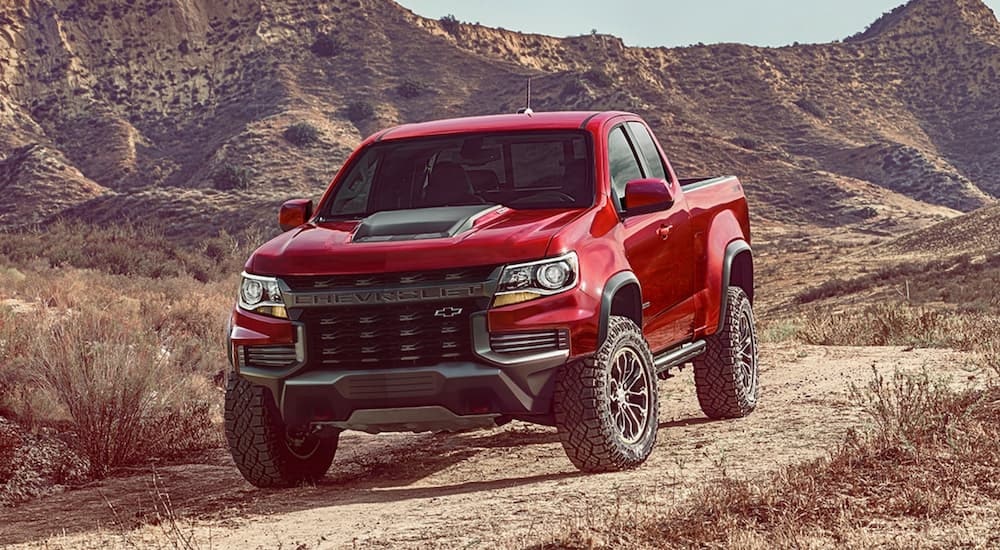
The History of Chevy Trucks Is the History of the Automotive Industry
You cannot tell the story of the past century of innovations without talking about the evolution of trucks. From the trucks that helped Americans in the European theater during World War Two to the trucks that let the average worker expand their zone of operations in the 1950s, so much of American history has been inextricably tied in with trucks made by manufacturers like Chevrolet. By looking at the evolution of Chevy, especially the more recent trucks, you can get a sense of why owning a used Chevy means you’re owning a piece of history.
Many of you might be interested in searching out used Chevy trucks for sale; it makes sense as the used market is hot right now, so it’s time to score a great deal. Faith’s Automotive has been helping Vermont drivers with our offerings of used Chevys. But you might find it intriguing to know how the Chevy truck got to where it is now so you can appreciate what you have and what it helped build. You can’t talk about the automotive industry without talking about Chevy trucks.
The Originals
The Model T, as opposed to Ford’s Model TT, hit the market in 1918. You won’t see this on the used market no matter where you go, but it’s an interesting historical artifact. While the truck’s bed was not as durable as today’s, it did gain a reputation for quality pretty quickly. It might not be able to hold as much as the Silverados of the past decade, but it outdid most other competition on the market. The Model T also showed labor businesses that investing in a truck would only help their bottom line. No more were automobiles just for the wealthy who wanted to show off; now, they were getting some serious work done.
By the 1930s, the truck revolution was well under way. Chevy charted the course with their Half Ton trucks (no points for guessing how much they weighed), which were initially called the Eagle series and then changed to the Masters series. These trucks brought some solid fuel efficiency to the Chevy lineup with 21 MPG, which is still a fairly competitive amount for trucks today and shows how Chevy trucks have always remained a step ahead of the competition.
Post-World War Two Era
As war exploded in Europe and the Pacific, America’s economy was put on a wartime footing. This meant almost all industries had to produce material to help the war effort. Hard as it may be to believe, production of vehicles halted unless the vehicle had a specific military purpose. Pickup trucks that were produced weren’t put onto the streets of Vermont but instead deployed in Europe or the islands of the Pacific.
However, when the war ended, the situation in America radically changed economically. All of a sudden, tens of thousands of soldiers returned home looking for jobs or planning to go to college thanks to the GI Bill. Over the following decade, Chevy trucks had to meet this changing status quo. As many of these returning soldiers moved to newly created suburbs, they tended to live a little further from their workplace than in the past. This made owning a truck more imperative as workers would have to bring their equipment over longer distances.
Unsurprisingly, Chevy put out multiple truck series over the decades following World War Two that sold very well due to their high quality and durability, which still define Chevy trucks today. The company’s biggest innovation was the Advance Design, a truck that laid the groundwork for almost all other trucks Chevy would produce up through our current era. The Advance Design held more seating than past vehicles, came with infotainment (a radio!), and climate control (a heater/defroster!). The front eventually received a grille upgrade that does not look radically different from those of today. While you probably won’t be buying a used Advance Design unless you’re a car collector, the Advance Design set the standard for trucks in the future and made Chevy into the powerful company it is today. There’s no Silverado or Colorado without the Advance Design.

The C/K Series: The Silverado’s Direct Precursor
Hard though it may be to believe, the seeds of Chevy’s famed Silverado were planted in 1960 when Chevy rolled out its C/K pickup truck. Not only could this truck tow a lot and handle a significant load in its bed, but it also rode better thanks to improved suspension. For the time, it was the closest a truck could get to the nimble drive of a sedan. This gave the average person access to a capability that could only be dreamed of a decade or so before while granting them a sense of control they were already familiar with.
The C/K lineup lasted for four generations, not concluding until 2002. You can still find some of those later models on the used car market today if you look hard. They hold up, too. By the end of the C/K lineup’s life, they were the cream of the crop, able to tow thousands of pounds and more than capable of handling a heavy payload and keeping it secure when the road turned bumpy. Their look evolved over the generations, becoming more imposing on the road, causing an immediate impression, and embracing a muscular structure reminiscent of the muscle cars of the late 1960s.
In the 1980s, the C/K truck saw its most significant upgrades. It gained a more aerodynamic design so that its performance on the road would be even better. The base structure was improved, and four-wheel drive with an independent suspension was introduced. The high towing amounts you see post-2000 Chevy trucks offering were able to come about largely due to this innovation.
During the decades of the C/K’s life, companies worldwide invested in the pickup trucks, adding them to their fleet for infrastructure projects. Whether it was rebuilding post-war Europe, expanding the suburbs, or crafting bigger and better cities, Chevy’s pickup trucks were at the forefront of industry. The value of a truck that can tow at a rate two or three times its own size (and eventually even more than that) cannot be overstated. Our modern world was put together by pieces transported in Chevy trucks.
The Dawn of the Silverado
If you go to any workplace, whether it’s a power plant or a construction site, you’re likely to see a Chevy Silverado or two. It’s virtually impossible to find an infrastructure project that doesn’t rely on pickup trucks to some degree. American industry survives due to efficiency, and there’s little more efficient than a Silverado. The Silverado evolved out of the C/K lineup to become the incredible truck it is today. It was originally offered as a trim of the C/K line before essentially taking over the lineup, with the C/K name retiring in 2002.
The Silverado’s impact on the car market was immediate and has never wavered. When you look at the specific stats of Silverados, it starts to become clear why they changed the market. The 2010 Silverado 1500 already offered a hybrid option, which put it far ahead of the hybrid and EV trends to come. In terms of power, the 2015 Silverado 2500 HD could tow 13,000 lbs, which is more than double its own size. When you get to the 3500 HD, models over the past decade can sometimes tow over 20,000 lbs. Is it a surprise that industries and laborers loved a vehicle like that? Drivers looking for a smaller, more maneuverable truck could get the midsize Colorado, which debuted in 2023.

The Allure of the Silverado and Colorado
You can see right here in Vermont why solid pickup trucks are necessary for our economy to run. No one needs to be told the details of how rough winters can get here. With pickup trucks featuring all-wheel drive, tires that excel at traction, and multiple driving modes, conquering the roads has never been easier. That’s necessary for anyone who uses their pickup for work. You’re a far more valuable company or laborer if poor weather doesn’t slow you down. That’s why Silverados and Colorados are so useful for Vermont drivers. That goes double for used models.
Why used? Because a used pickup truck is a far more economical purchase. Plus, when used Chevy pickups have towing capacities of 13,000 lbs, incredible horsepower, and are built to last for years and years, when you purchase used, you’re still getting one of the most competitive pickups on the market today. Whether you own your own company or work for one, a Chevy pickup truck needs to be yours. It lets you get whatever you need not only done but done safely and quickly. You’ll be able to be an integral part of not just Vermont’s industry but all of America’s. Chevy pickups have long been a part of the United States’ economic success; it’s time for you to make one part of yours.


